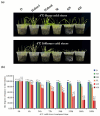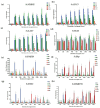Comparative Transcriptome Analysis of Two Types of Rye Under Low-Temperature Stress
- PMID: 40136425
- PMCID: PMC11941637
- DOI: 10.3390/cimb47030171
Comparative Transcriptome Analysis of Two Types of Rye Under Low-Temperature Stress
Abstract
Wheat is a crucial food crop, and low-temperature stress can severely disrupt its growth and development, ultimately leading to a substantial reduction in wheat yield. Understanding the cold-resistant genes of wheat and their action pathways is essential for revealing the cold-resistance mechanism of wheat, enhancing its yield and quality in low-temperature environments, and ensuring global food security. Rye (Secale cereale L.), on the other hand, has excellent cold resistance in comparison to some other crops. By studying the differential responses of different rye varieties to low-temperature stress at the transcriptome level, we aim to identify key genes and regulatory mechanisms related to cold tolerance. This knowledge can not only deepen our understanding of the molecular basis of rye's cold resistance but also provide valuable insights for improving the cold tolerance of other crops through genetic breeding strategies. In this study, young leaves of two rye varieties, namely "winter" rye and "victory" rye, were used as experimental materials. Leaf samples of both types were treated at 4 °C for 0, 6, 24, and 72 h and then underwent RNA-sequencing. A total of 144,371 Unigenes were reconstituted. The Unigenes annotated in the NR, GO, KEGG, and KOG databases accounted for 79.39%, 55.98%, 59.90%, and 56.28%, respectively. A total of 3013 Unigenes were annotated as transcription factors (TFs), mainly belonging to the MYB family and the bHLH family. A total of 122,065 differentially expressed genes (DEGs) were identified and annotated in the GO pathways and KEGG pathways. For DEG analysis, 0 h 4 °C treated samples were controls. With strict criteria (p < 0.05, fold-change > 2 or <0.5, |log2(fold-change)| > 1), 122,065 DEGs were identified and annotated in GO and KEGG pathways. Among them, the "Chloroplast thylakoid membrane" and "Chloroplast" pathways were enriched in both the "winter" rye and "victory" rye groups treated with low temperatures, but the degrees of significance were different. Compared with "victory" rye, "winter" rye has more annotated pathways such as the "hydrogen catabolic process". Although the presence of more pathways does not directly prove a more extensive cold-resistant mechanism, these pathways are likely associated with cold tolerance. Our subsequent analysis of gene expression patterns within these pathways, as well as their relationships with known cold-resistance-related genes, suggests that they play important roles in "winter" rye's response to low-temperature stress. For example, genes in the "hydrogen catabolic process" pathway may be involved in regulating cellular redox balance, which is crucial for maintaining cell function under cold stress.
Keywords: cold-resistant candidate genes; low-temperature stress; rye; transcriptome.
Conflict of interest statement
The authors declare no conflicts of interest.
Figures







Similar articles
-
Short-Term Memory Impairment.2024 Jun 8. In: StatPearls [Internet]. Treasure Island (FL): StatPearls Publishing; 2025 Jan–. 2024 Jun 8. In: StatPearls [Internet]. Treasure Island (FL): StatPearls Publishing; 2025 Jan–. PMID: 31424720 Free Books & Documents.
-
Sexual Harassment and Prevention Training.2024 Mar 29. In: StatPearls [Internet]. Treasure Island (FL): StatPearls Publishing; 2025 Jan–. 2024 Mar 29. In: StatPearls [Internet]. Treasure Island (FL): StatPearls Publishing; 2025 Jan–. PMID: 36508513 Free Books & Documents.
-
Signs and symptoms to determine if a patient presenting in primary care or hospital outpatient settings has COVID-19.Cochrane Database Syst Rev. 2022 May 20;5(5):CD013665. doi: 10.1002/14651858.CD013665.pub3. Cochrane Database Syst Rev. 2022. PMID: 35593186 Free PMC article.
-
Survivor, family and professional experiences of psychosocial interventions for sexual abuse and violence: a qualitative evidence synthesis.Cochrane Database Syst Rev. 2022 Oct 4;10(10):CD013648. doi: 10.1002/14651858.CD013648.pub2. Cochrane Database Syst Rev. 2022. PMID: 36194890 Free PMC article.
-
Home treatment for mental health problems: a systematic review.Health Technol Assess. 2001;5(15):1-139. doi: 10.3310/hta5150. Health Technol Assess. 2001. PMID: 11532236
Cited by
-
Integrative Physiological and Transcriptomic Analysis Reveals Metabolic Adaptation and Cold-Tolerance Marker Development in Winter Rye Under Low-Temperature Stress.Plants (Basel). 2025 May 23;14(11):1588. doi: 10.3390/plants14111588. Plants (Basel). 2025. PMID: 40508262 Free PMC article.
References
-
- Gaikpa D.S., Koch S., Fromme F.J., Siekmann D., Würschum T., Miedaner T. Genome-wide association mapping and genomic prediction of Fusarium head blight resistance, heading stage and plant height in winter rye (Secale cereale) Plant Breed. 2020;139:508–520. doi: 10.1111/pbr.12810. - DOI
-
- Ahrends H.E., Piepho H.-P., Sommer M., Ewert F., Webber H. Is the volatility of yields for major crops grown in Germany related to spatial diversification at county level? Environ. Res. Lett. 2024;19:104061. doi: 10.1088/1748-9326/ad7613. - DOI
LinkOut - more resources
Full Text Sources

